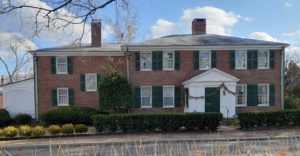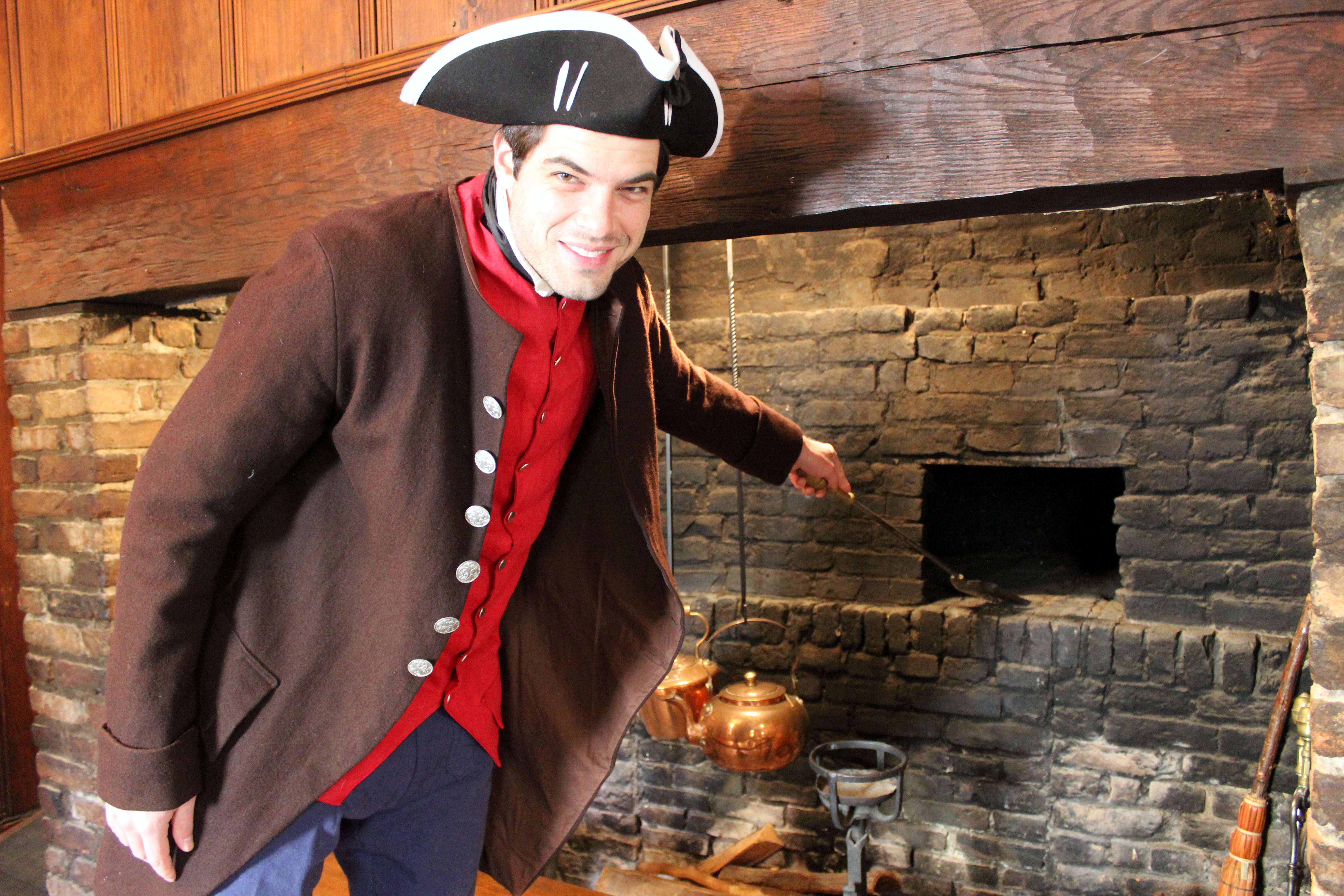The Old Hooper-Lee House by Thomas Coffin Amory
From the Proceedings, Volume 16, p. 21-25
[The following is taken, by permission, from the little-known article by Thomas Coffin Amory (H. C. 1830) entitled “Old Cambridge and New,” in the Register of the New England Historic-Genealogical Society for July, 1871. It gives an interesting picture of the house some sixty years ago — very nearly in its original condition — not the less interesting because one of the earliest accounts marked by sympathetic intelligence and critical detail. — S. F. B.]
The mansion next west of the Lechmere house was the residence of Judge Lee, and down to 1860 belonged to one of his family. It has the reputation of being the oldest building in Cambridge certainly, dating much earlier than any other of equal note still remaining in anything approaching its pristine condition. Its foundations and mason work are cemented with clay, and this confirms the popular belief that it was erected before the days of Charles the Second, for lime came in this neighborhood into use for mortar at a later period, clay mixed with pulverized oyster shells being previously used instead. Its oak timbers, where exposed to view, present the same indications of extreme age as those in the cellar of the Edmund Quincy house in Quincy, now occupied by Mr. Butler. Although more elegant than the houses of the same period in Ipswich, it has to them many points of resemblance. The central chimney, twelve feet in either direction, is built on the natural surface of the ground, cellars being excavated on either side, one of them having a sub-cellar for fruit. The rooms are arranged in the same mode around the chimney, which thus afforded spacious fireplaces to the drawing room on one side, to the keeping room on the other, and to what was originally the kitchen, but now a handsome dining-room, in the rear.
The house is over sixty feet front, and the parlors and rooms over them would be twenty by twenty-six were it not that in many of them, as in the Ipswich houses, a portion of the end six feet in breadth opposite the fireplaces was partitioned off, in the keeping room for a study, in the chambers above for bed or dressing rooms, the window between either shut off by a glass door or set as it were in a recess. The object was protection against the cold. All the heat radiating from the centre stack, the portion of the rooms farthest removed, the end wall being imperfectly sealed and windows not very tight, would have lost its warmth with the thermometer below zero, but for this shield. The drawing-room, however, preserves all its plentitude of size, and appears the larger for its low ceilings, across which and around which extend engaged beams. The paper hangings, as in other apartments, are in designs of former days, landscape and buildings, men and beasts, like those of the Lee house in Marblehead and probably as ancient, those having been placed there under the King. Out of the drawing-room, as in all the better houses of two centuries ago, opened a door into the kitchen and another into a sleeping room of handsome proportions, and between them was an enclosed staircase and door towards the stables.
The main staircase in the front hall opposite the principal door of entrance leads up in front of the chimney stack, and is of easy ascent and handsome construction. The hall projects beyond the front of the house, as in the Waterhouse and Holmes mansions on the common and in the old Dunster house formerly on Harvard street, windows on either side of the porch so formed affording light and contributing to cheerfulness. The windows are peculiar, of great breadth for the height, indeed nearly square, and in their original state were no doubt glazed in lozenge panes set in leaden lattices. The floors are not all level. This would seem the effect of age, were it not that in other ancient houses it was evidently from design. At Little Harbor in the Wentworth, and in the Barrell house at York, some of the principal rooms vary in level several feet. There is a step down into the dining-room in this house from the drawing-room, and its floor is an inch or more above that of the hall. Besides the two flights of stairs mentioned, there is another from a hall leading out of the keeping room.
Above are several pleasant sleeping rooms on two floors. Back of those on the upper formerly ran a gallery, sixty feet by twelve or fifteen, now divided into chambers. In its furniture there is a happy combination of modern with ancient; one delightful apartment, with its superb four-poster, decorated cabinets and hangings like tapestry, its small dressing rooms partitioned off, being peculiarly attractive. The great fireplaces have disappeared, and modern simplicity eschews the gorgeous attire of richly tinted satins and velvets ablaze with gold lace and paste diamonds then in vogue; but no one can visit one of these old mansions in a good state of preservation, permitted by the good taste of its occupants to retain the characteristics of the olden time, without observing at every turn some peculiarity, not only to attract attention but to raise a doubt whether the arts of life as they advance are altogether improvements.
Sitting a few afternoons since in its delightful drawing-room, with the amiable hostess of the mansion, she mentioned several traditions connected with the house. Among others, she described the incidents of a festal occasion a century ago in that very apartment, related to her by a maiden lady long since passed away at an advanced age. It was perhaps rash to promise to put it into print, but promises the least reasonable should be respected. The lady said that the occupants of this aristocratic quarter made it their especial pride and boast that they had no work to do, and entertained little respect for those that had. As the daughter of the president of the college, however, an exception was made in her favor, and she was in her girlhood invited to a June festivity at Judge Lee’s. It was a strawberry party, that fruit being then raised on these places in great profusion and of rare excellence. The company assembled early in the afternoon in costly apparel, and their manners excessively polite were much more formal and ceremonious than anything we know. Eating and drinking then constituted a principal part of social entertainments, and there was a ceaseless round of waiters loaded with jellies and creams and other pleasant contrivances, with wine and lemonade, of which it was considered good breeding liberally to partake. Conversation or social interchange appeared somewhat secondary to the duty of refreshment, and when ample justice had been done to this ambulatory repast, as dusk deepened into night, the guests took their leave. They probably had gayer times in those good old days of which Baroness Riedesel tells us.
The estate extended to Fresh Pond, and also it is believed to the river, and consisting of good soil was well cultivated and productive. In the rear of the mansion were clustered every variety of subordinate building and office essential to an extensive farm, when persons of means killed their own mutton, made their cider and beer, and wove their own cloth. These buildings being in a decayed condition when the present occupant entered into possession, were removed. A century ago the house stood remote from any other, evidently in its day, as it is even now, a dwelling of unusual elegance, and than which when erected there could have been few out of the larger towns superior in the province. If not substantially rebuilt when Judge Lee purchased it, in 1758, it was probably altered and improved by him. Much of the finish dates from that period. He bought it of Faith, widow of Cornelius Waldo, to whom it was conveyed in 1733 by Dr. Henry Hooper, son of Richard, also a physician, settled in Watertown. Of the family who for more than a century were proprietors of this interesting relic of the past, and many of whom have been generous contributors to the college and other public objects, some brief account may not be out of place.
Thomas Lee, father of the Judge, died in 1766, at the age of ninety-three, having in his long and useful life as a builder of ships and in commerce in Boston accumulated a large estate. His name, formerly inscribed over one of its library alcoves, indicated that he had been a benefactor of the college, where his sons graduated, Thomas in 1722, and Joseph in 1729. Governor Phips, whose daughter Joseph married, died in 1757, and her inheritance united with his own made them rich. He was much esteemed and popular, but his appointment by the crown in 1774 to the council contrary to the provisions of the provincial charter created some prejudice against him, and with his neighbor Oliver he was mobbed. He found it prudent to leave Cambridge, and went first to Philadelphia and subsequently to New Jersey, but having influential friends among the patriots, his property was not confiscated and he soon returned and resumed possession. Having no children he built a house to the left of his own for his nephew Thomas, to whom he left the Cambridge estate, and whose daughter, Mrs. Carpenter, still owned part of it with the mansion down to 1860. Another daughter was the second wife of Dr. Waterhouse, and his son.
George Gardner Lee, H. C. 1792, who died in 1816, was an officer in our navy. The widow of George, daughter of Dr. Sawyer of Newburyport, was the well-known authoress of the Three Experiments of Living and other popular works.
Joseph, the other nephew of the Judge, married the sister of George Cabot, and left six sons, Joseph, Nathaniel, George, Thomas, Henry and Francis, besides daughters, one the first wife of Judge Jackson, and two never married. Henry, an eminent and much respected merchant, was the well-known writer on political economy, the friend and correspondent of Tooke, Cobden and Ricardo, McCullock and numerous other English statisticians. Thomas, who married the sister of the saintly Buckminister, also a distinguished authoress, was a benefactor of Harvard. He adorned our Commonwealth Avenue Mall with a fine granite statue of Alexander Hamilton, by Rimmer, and our public garden with a monument, the joint production of Ward and Van Brunt, representing the Good Samaritan, in commemoration of the discovery of anaesthetics. Its object was to preserve the credit of this almost unparalleled blessing to humanity, to the city of many notions, where it justly belongs, though Edinburgh lays claim for the late Sir James Simpson to the application later of chloroform as a substitute for ether






